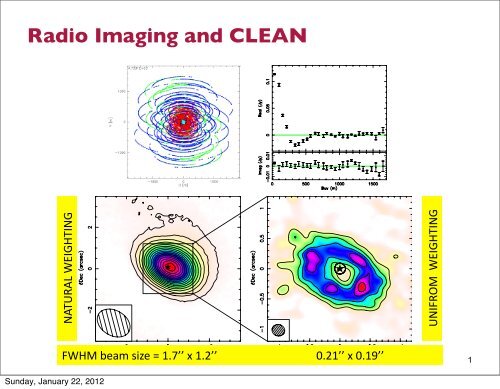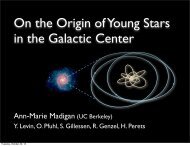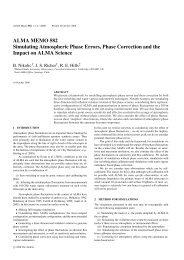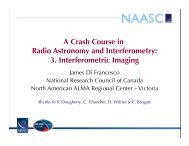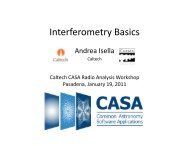Radio Imaging and CLEAN - NRAO
Radio Imaging and CLEAN - NRAO
Radio Imaging and CLEAN - NRAO
Create successful ePaper yourself
Turn your PDF publications into a flip-book with our unique Google optimized e-Paper software.
<strong>Radio</strong> <strong>Imaging</strong> <strong>and</strong> <strong>CLEAN</strong><br />
!"#$%"&'()*+,#*!+'<br />
Sunday, January 22, 2012<br />
-(,/'0123'4561'7'89:;;'9=8;;'
Credits<br />
• Slides borrowed from :<br />
– https://science.nrao.edu/facilities/alma/naasc-workshops/almadata/indebetouw.pdf<br />
• “<strong>Imaging</strong> ALMA Data” by Remy Indebetouw<br />
• In turn borrowed from David Wilner, Steve Myers, <strong>and</strong> Scott Schnee<br />
– http://www.almatelescope.ca/workshop/Talks/CASA<strong>Imaging</strong>_Hamilton.pdf<br />
• “<strong>Imaging</strong> with CASA” by Crystal Brogan<br />
– http://www.aoc.nrao.edu/events/synthesis/2010/lectures/wilner_synthesis10.pdf<br />
• “<strong>Imaging</strong> <strong>and</strong> Deconvolution” by David Wilner @ VLA Summer School<br />
– http://www.das.inpe.br/school/2011/lectures/RickPerley_Lecture4.pdf<br />
• “<strong>Imaging</strong> <strong>and</strong> Deconvolution” by Rick Perley<br />
• General references<br />
– Thompson, A.R., Moran, J.M., & Swensen, G.W., “Interferometry <strong>and</strong> Synthesis in<br />
<strong>Radio</strong> Astronomy”<br />
– VLA Summer School Lectures (available online)<br />
Sunday, January 22, 2012<br />
2
Outline<br />
• Brief review of synthesis imaging<br />
• Demonstration of deconvolution (i.e, “clean”)<br />
• CASA clean - basics<br />
– images<br />
– imsize, cell size, mode, mask<br />
– when to stop cleaning<br />
– weighting<br />
• CASA clean - advanced topics<br />
– multiscale clean<br />
– combining interferometry data with single dish<br />
– self-calibration<br />
– mosaicking<br />
Sunday, January 22, 2012<br />
3
From Sky Brightness to Visibility<br />
1. An interferometer measures the interference pattern produced by<br />
two apertures.<br />
2. The interference pattern is directly related to the source brightness.<br />
For small fields of view the complex visibility, V(u,v), is the 2D<br />
Fourier transform of the brightness on the sky, T(l,m)<br />
van Cittert-Zernike theorem<br />
Fourier space/domain<br />
Image space/domain<br />
Sunday, January 22, 2012<br />
image plane<br />
l<br />
uv plane<br />
T(l,m)<br />
4<br />
m
<strong>Imaging</strong> <strong>and</strong> Deconvolution<br />
• Consequences of finite uv coverage<br />
– no data beyond umax, vmax → unresolved structure<br />
– no data within umin, vmin → limit on largest size scale<br />
– holes between umin,vmin <strong>and</strong> umax, vmax → sidelobes<br />
• Empty (u,v) cells can have ANY value<br />
• Noise → undetected/corrupted structure in T(l,m)<br />
• Interpolate/extrapolate observed V(u,v) values to fill in empty<br />
uv cells<br />
An infinite number of T(l,m) compatible with observed V(u,v)<br />
Sunday, January 22, 2012<br />
8
Deconvolution Algorithms<br />
• <strong>CLEAN</strong> (Högbom 1974)<br />
– assumes T(l,m) is a collection of point sources<br />
– multi-scale <strong>CLEAN</strong> relaxes this assumption<br />
• Maximum Entropy (Gull & Skilling 1983)<br />
– assumes T(l,m) is smooth <strong>and</strong> positive<br />
• Beam shape<br />
– needed to deconvolve image<br />
– atmospheric seeing can modify effective beam shape<br />
Sunday, January 22, 2012<br />
9
• Find brightest points in dirty image<br />
Sunday, January 22, 2012<br />
10
• Find brightest points in dirty image<br />
• Create model image containing a<br />
fraction of those flux points<br />
Sunday, January 22, 2012<br />
11
• Find brightest points in dirty image<br />
• Create model image containing a<br />
fraction of those flux points<br />
• Subtract model from data,<br />
leaving a residual<br />
Sunday, January 22, 2012<br />
12
• Find brightest points in dirty image<br />
• Create model image containing a<br />
fraction of those flux points<br />
• Subtract model from data,<br />
leaving a residual<br />
• Final product = residual + model<br />
(convolved with restoring<br />
Gaussian beam)<br />
Sunday, January 22, 2012<br />
13
Sunday, January 22, 2012<br />
residual (log scale) model convolved w/ restorimg beam (log scale)<br />
residual (linear scale)<br />
cleaned image (log scale)<br />
14
Sunday, January 22, 2012<br />
residual (log scale) model convolved w/ restoring beam (log scale)<br />
residual (linear scale)<br />
restrict where the algorithm<br />
can search for clean<br />
components, with a mask<br />
cleaned image (log scale)<br />
15
Sunday, January 22, 2012<br />
residual (log scale) model convolved w/ restoring beam<br />
residual (linear scale)<br />
10 iterations<br />
cleaned image (log scale)<br />
16
Sunday, January 22, 2012<br />
residual (log scale) model convolved w/ restoring beam<br />
residual (linear scale)<br />
20 iterations<br />
cleaned image (log scale)<br />
17
Sunday, January 22, 2012<br />
residual (log scale) model convolved w/ restoring beam<br />
residual (linear scale)<br />
30 iterations<br />
cleaned image (log scale)<br />
18
Sunday, January 22, 2012<br />
residual (log scale) model convolved w/ restoring beam<br />
residual (linear scale)<br />
40 iterations<br />
cleaned image (log scale)<br />
19
Sunday, January 22, 2012<br />
residual (log scale) model convolved w/ restoring beam<br />
residual (linear scale)<br />
50 iterations<br />
cleaned image (log scale)<br />
20
Sunday, January 22, 2012<br />
residual (log scale) model convolved w/ restoring beam<br />
residual (linear scale)<br />
60 iterations<br />
cleaned image (log scale)<br />
21
Sunday, January 22, 2012<br />
residual (log scale) model convolved w/ restoring beam<br />
residual (linear scale)<br />
70 iterations<br />
cleaned image (log scale)<br />
22
Sunday, January 22, 2012<br />
residual (log scale) model convolved w/ restoring beam<br />
residual (linear scale)<br />
80 iterations<br />
cleaned image (log scale)<br />
23
Sunday, January 22, 2012<br />
residual (log scale) model convolved w/ restoring beam<br />
residual (linear scale)<br />
90 iterations<br />
cleaned image (log scale)<br />
24
Sunday, January 22, 2012<br />
residual (log scale) model convolved w/ restoring beam<br />
residual (linear scale)<br />
100 iterations<br />
cleaned image (log scale)<br />
25
Sunday, January 22, 2012<br />
residual (log scale) model convolved w/ restoring beam<br />
residual (linear scale)<br />
125 iterations<br />
cleaned image (log scale)<br />
26
Sunday, January 22, 2012<br />
residual (log scale) model convolved w/ restoring beam<br />
residual (linear scale)<br />
150 iterations<br />
cleaned image (log scale)<br />
27
Sunday, January 22, 2012<br />
residual (log scale) model convolved w/ restoring beam<br />
residual (linear scale)<br />
200 iterations<br />
cleaned image (log scale)<br />
28
Sunday, January 22, 2012<br />
residual (log scale) model convolved w/ restoring beam<br />
residual (linear scale)<br />
300 iterations<br />
cleaned image (log scale)<br />
29
Sunday, January 22, 2012<br />
residual (log scale) model convolved w/ restoring beam<br />
residual (linear scale)<br />
400 iterations<br />
cleaned image (log scale)<br />
30
Sunday, January 22, 2012<br />
residual (log scale) model convolved w/ restoring beam<br />
residual (linear scale)<br />
500 iterations<br />
cleaned image (log scale)<br />
31
Sunday, January 22, 2012<br />
residual (log scale) model convolved w/ restoring beam<br />
residual (linear scale)<br />
1000 iterations<br />
cleaned image (log scale)<br />
32
Sunday, January 22, 2012<br />
residual (log scale) model convolved w/ restoring beam<br />
residual (linear scale)<br />
1500 iterations<br />
cleaned image (log scale)<br />
33
Deconvolution<br />
Results depend on:<br />
• image parameters: size, cell, weighting, gridding, mosaic<br />
• deconvolution parameters: algorithm, iterations, boxing, stopping criteria<br />
Sunday, January 22, 2012<br />
dirty image (log scale)<br />
cleaned image (log scale)<br />
34
CASA: inputs to “clean”<br />
Sunday, January 22, 2012<br />
35
imagename<br />
Sunday, January 22, 2012<br />
36
imagename<br />
• .image<br />
– final cleaned image (or dirty image if niter=0)<br />
• .psf<br />
– point spread function, or “dirty beam”<br />
• .model<br />
– image of the clean components<br />
• .residual<br />
– residual image after subtracting clean components<br />
– check to see if more cleaning is needed<br />
• .flux<br />
– relative sky sensitivity over field<br />
– pbcor=True divides the .image by the .flux<br />
– higher noise at edge of image<br />
Sunday, January 22, 2012<br />
37
imsize <strong>and</strong> cell<br />
Sunday, January 22, 2012<br />
38
imsize <strong>and</strong> cell<br />
• cell<br />
– should satisfy sampling theorem for the longest baselines,<br />
Δx < 1/(2 u max ), Δy < 1/(2 v max )<br />
– in practice, 3 to 5 pixels across the main lobe of the dirty beam<br />
• imsize<br />
– natural resolution in (u,v) plane samples FT{A(x,y)}, implies image size<br />
2x primary beam<br />
– primary bean ~ 1.2 * λ/D, D = telescope diameter<br />
– e.g., ALMA: 870 µm, 12 m telescope → 2 x 18 arcsec<br />
* not restricted to powers of 2 (in fact internal padding complicates)<br />
* if there are bright sources in the sidelobes of A(x,y), then they will be<br />
aliased into the image (need to make a larger image)<br />
Sunday, January 22, 2012<br />
39
plotuv<br />
Sunday, January 22, 2012<br />
40
im.advise<br />
Sunday, January 22, 2012<br />
0.5/maxuv – absolute minimum;<br />
recommend < 0.2/maxuv = 1.1arcsec<br />
41
mode<br />
Sunday, January 22, 2012<br />
42
mode<br />
• mode = mfs (multi-frequency synthesis)<br />
– sum each channel to make a continuum image<br />
– nterm: models the sky-frequency dependence of the continuum<br />
• mode = channel, velocity, or frequency<br />
– data: taken in sky frequency (terrestrial, TOPO) frame<br />
• velocity: include doppler shifts from:<br />
– Earth rotation: few km/s (diurnal)<br />
– Earth orbit: 30 km/s (annual)<br />
– Earth/Sun motion w.r.t. LSR (e.g. LSRK, LSRD)<br />
– maybe galactic rotation to extragalactic frames<br />
– imaging applies doppler corrections on the fly, works in LSRK<br />
– you choose the subsequent output cube parameters<br />
• nchan, start, width specify which channels to image<br />
– can shift <strong>and</strong> regrid data before imaging using cvel<br />
Sunday, January 22, 2012<br />
43
When to stop cleaning? : niter & threshold<br />
Sunday, January 22, 2012<br />
44
When to stop cleaning? : niter & threshold<br />
• niter<br />
– Maximum number of clean interations to perform.<br />
– Set niter=0 for dirty map OR set to large number<br />
– use “threshold” to terminate cleaning<br />
• threshold<br />
– stop cleaning when peak residual has this value<br />
– set to multiple of rms noise if noise-limited<br />
OR<br />
fraction of brightest source peak flux if dynamic range limited<br />
Sunday, January 22, 2012<br />
45
mode<br />
Sunday, January 22, 2012<br />
46
Dirty Beam Shape –1– <strong>and</strong> Weighting<br />
• introduce weighting function W(u,v)<br />
S(l, m) =F −1 {W (u, v) × S(u, v)}<br />
– W modifies dirty beam<br />
• “Natural” weighting<br />
– W(u,v) = 1/σ 2 (u,v) at points with data <strong>and</strong><br />
zero elsewhere, where σ 2 (u,v) is the noise<br />
variance of the (u,v) sample<br />
– maximizes point source sensitivity<br />
– (lowest rms in image)<br />
– generally more weight to short baselines (large<br />
spatial scales), degrades resolution<br />
Sunday, January 22, 2012<br />
47
Dirty Beam Shape <strong>and</strong> Weighting<br />
• “Uniform” weighting<br />
– W(u,v) is inversely proportional to local<br />
density of (u,v) points<br />
– fills (u,v) plane more uniformly, so<br />
(outer) sidelobes are lower<br />
– gives more weight to long baselines <strong>and</strong><br />
therefore higher angular resolution<br />
– degrades point source sensitivity<br />
(higher rms in image)<br />
– can be trouble with sparse sampling:<br />
cells with few data points have same weight<br />
as cells with many data points<br />
Sunday, January 22, 2012<br />
48
Dirty Beam Shape <strong>and</strong> Weighting<br />
• “Robust” (Briggs) weighting<br />
– variant of “uniform” that avoids giving too much<br />
weight to cell with low natural weight<br />
– an adjustable parameter that allows for<br />
continuous variation between highest angular<br />
resolution <strong>and</strong> optimal point source sensitivity<br />
– large threshold → natural weighting<br />
– small threshold → uniform weighting<br />
– robust ~ 0 to 1 gives good results<br />
Sunday, January 22, 2012<br />
49
Dirty Beam Shape <strong>and</strong> Weighting<br />
• “Tapering”<br />
– apodize the (u,v) sampling by a Gaussian<br />
t = tapering parameter (in kλ; arcsec)<br />
– like smoothing in the image plane (convolution<br />
by a Gaussian)<br />
– gives more weight to short baselines, degrades<br />
angular resolution<br />
– degrades point source sensitivity but can<br />
improve sensitivity to extended structure<br />
Sunday, January 22, 2012<br />
50
Example of Natural vs. Uniform Weighting<br />
!"#$%"&'()*+,#*!+'<br />
Sunday, January 22, 2012<br />
-(,/'0123'4561'7'89:;;'9=8;;'
Weighting <strong>and</strong> Tapering: Summary<br />
• imaging parameters provide a lot of freedom<br />
• appropriate choice depends on science goals<br />
Robust/Uniform Natural Taper<br />
Resolution higher medium lower<br />
Sidelobes lower higher depends<br />
Point Source<br />
Sensitivity<br />
Extended Source<br />
Sensitivity<br />
Sunday, January 22, 2012<br />
lower maximum lower<br />
lower medium higher<br />
52
mask<br />
Sunday, January 22, 2012<br />
53
mask<br />
• Define region where you expect the emission to be<br />
• <strong>CLEAN</strong> components will fall within the masked region<br />
• can also define with interactive=True<br />
Sunday, January 22, 2012<br />
54
Interactive Clean<br />
residual image in viewer<br />
define a mask with R-click on<br />
shape type<br />
define the same mask for all<br />
channels<br />
or iterate through the channels<br />
with the tape deck <strong>and</strong> define<br />
separate masks<br />
Sunday, January 22, 2012<br />
55
nteractive Clean<br />
perform N iterations<br />
<strong>and</strong> return – every time the<br />
residual is displayed is a major<br />
cycle<br />
continue until #cycles<br />
or threshold reached,<br />
or user stop<br />
Sunday, January 22, 2012<br />
56
multiscale clean<br />
• Models the sky using components with different size scales<br />
• multiscale = [0,5,15,45]<br />
– scales are in units of pixels<br />
– 0=point, typically 1-2x synthesized beam, then multiples of 2-3x that up to<br />
a fraction of the PB can be tricky to get to work right<br />
• Yields promising results on extended sources<br />
• See, e.g., Rich et al. 2008, AJ, 136, 2897 for comparison between clean <strong>and</strong><br />
multiscale clean<br />
Sunday, January 22, 2012<br />
57
multiscale clean<br />
Sunday, January 22, 2012<br />
multiscale “classic” 1-scale<br />
58
zero-spacing<br />
Low Spatial Frequencies (I)<br />
• Large Single Telescope<br />
– make an image by scanning across the sky<br />
– all Fourier components from 0 to D sampled, where D is the<br />
telescope diameter (weighting depends on illumination)<br />
– Fourier transform single dish map = T(x,y) $ A(x,y), then divide<br />
by a(x,y) = FT{A(x,y)}, to estimate V(u,v)<br />
– choose D large enough to overlap interferometer samples of<br />
V(u,v) <strong>and</strong> avoid using data where a(x,y) becomes small<br />
Sunday, January 22, 2012<br />
density of<br />
uv points<br />
(u,v)<br />
63<br />
59
zero-spacing<br />
Low Spatial Frequencies (II)<br />
• separate array of smaller telescopes<br />
– use smaller telescopes observe short baselines not<br />
accessible to larger telescopes<br />
– shortest baselines from larger telescopes total power maps<br />
Sunday, January 22, 2012<br />
ALMA with ACA<br />
50 x 12 m: 12 m to 14 km<br />
+12 x 7 m: fills 7 to 12 m<br />
+ 4 x 12 m: fills 0 to 7 m<br />
64<br />
60
self calibration<br />
• phase calibration is not perfect<br />
– gain solution interpolated from different time, <strong>and</strong> different location on the<br />
sky<br />
• self-calibration corrects for gain errors from on-source observations<br />
– N complex gains, where N = number of antennas<br />
– N(N-1)/2 visibilities<br />
– over constrained problem is N is large <strong>and</strong> source structure is simple<br />
– required sufficient signal-to-noise at each time interval<br />
• procedure<br />
– assume initial model<br />
– solve for time-dependent gains<br />
– form new sky model from corrected data using <strong>CLEAN</strong><br />
– solve for new gains<br />
Sunday, January 22, 2012<br />
61
mosaicking<br />
• image multiple pointings of the antennas<br />
• imagermode = ‘mosaic’<br />
• mosweight = True<br />
– weights pointings by sensitivity in overlap regions<br />
• field = ‘’<br />
– selects fields to mosaic<br />
• ftmachine<br />
– ftmachine=‘mosaic’<br />
• add in uv plane <strong>and</strong> invert together<br />
– ftmachine=’ft’<br />
• shift <strong>and</strong> add in image plane<br />
Sunday, January 22, 2012<br />
62


